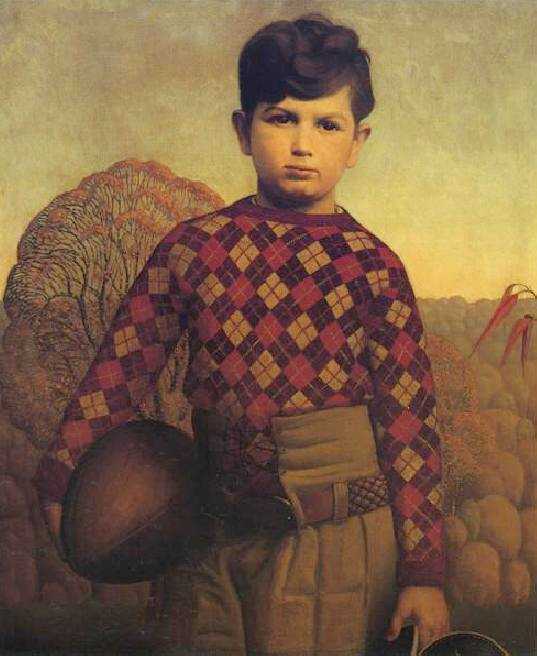
Artists: Grant Wood (United States, 1892-1942)

Figure 1.--The boy in the argyle sweater is Melvin Blumberg of Clinton, Iowa, whose
mother, a client of Grant Wood's, got the painter in 1931 to depict her son in
his favorite clothing, the red and tan argyle sweater and padded football pants with braided belt. Note the football in the boy's hands.
|
Grant Wood is an important American artist. He was not an artist I was very familiar with, except for "American Gothic". Another important painting is his ssartyrical painting of three Daughters of the American Revolution (DAR). Wood like Mrs. Roosevelt had a iunplesant experiebce with the DAR. The Renwick Gallery in Washington during had an important exhibition on Wood which surveyed his impressive body of work. He did both portaits and pastoral landscapes. The portraits included a few children, done in a rather conservative style rather than the more styilized landscape paintings. Wood is usually classed with other American painters such as Thomas Hart Benton and John Stuert Curry in a group known as "The American Scene" who were attracted to American rural
subject matter. They became popular in the early 1930s during the Great Depression.
Parents
Childhood
Grant Wood was born in 1892 in Anamosa, Iowa, and lived most of his
short career in Cedar Rapids.
Education
Wood studied at the Minneapolis School of Design, becoming a professional designer while attending the University of Iowa. He also studied at the Art Institute of Chicago.
Travel
Wood had a brief sojourn in Europe (mostly Paris) in the early 1920s, and also
visited Sorrento, Italy. Visiting Europe again in 1928, he discovered the Dutch and German primitive painters, whom he partly imitated in his best-known American works.
Style
Influenced by Renaissance painters such as Holbein, Wood also cultivated a somewhat satirical style in paintings such as "The Booster" (depicting a famous subject treated by the novelist Sinclair Lewis. Another important painting is his satyrical painting of three Daughters of the American Revolution (DAR). Wood like Mrs. Roosevelt had a unplesant experiebce with the DAR.
Body of Work
Wood was not an artist I was very familiar with, except for "American Gothic". The Renwick Gallery in Washington during had an important exhibition on Wood which surveyed his impressive body of work. He did both portaits and pastoral landscapes.
Children
The portraits included a few children, more conservative artistically. Perhaps because they were done for clients and friends. His more famous works such as "American Gothic" (painted in 1930) that go in for a kind of stylized primativism that is even more striking in his landscapes. I know of two paintings of children, although there may be a few more.
Melvin Blumberg (1931)
The boy in the argyle sweater is Melvin Blumberg of Clinton, Iowa, whose
mother, a client of Grant Wood's, got the painter in 1931 to depict her son in
his favorite clothing, the red and tan argyle sweater and padded football pants with braided belt. Note the football in the boy's hands. Melvin was about 11 or 12 years old at the time. Most mothers insisted that boys dress up in their best outfits for formal portraits. Melvin, however, was allowed to wear his football clothes.
Another child pprtrait was painted in 1929. It shows young Gordon Fennell, Jr. (aged about 5) sitting in a large overstuffed chair with a ball in his hands. He wears a white blouse with a Peter Pan collar and string tie with tassels. He also wears button-on short pants. Unfortunately we have only a black and white reproduction. This is a wonderfully executed portrait, but illustrates a difficulty faced by artists in the modern age. I'm not sure the portait here adds anything a photograph would not have provided.
The American Scene
Grant Wood is an important American artist. Wood is usually classed with other American painters such as Thomas Hart Benton and John Stuert Curry in a group known as "The American Scene" who were attracted to American rural
subject matter. They became popular in the early 1930s during the Great Depression.
Final Years
When the economic crisis of the Great Depression began
to wane in the years just before World War II, Wood's obvious Americanism began to lose favor with the critics, and Wood was deeply affected by his loss of artistic status. He died in considerable disillusionment in 1942.
HBC

Navigate the Boys' Historical Clothing artistic pages:
[Return to the Main individual G-L artist page]
[Return to the Main Americn artist page]
[Return to the Main artistic page]
[Chronologies]
[Individuals]
[National]
[Styles]
Navigate the Boys' Historical Clothing Web Site:
[Introduction]
[Activities]
[Biographies]
[Chronology]
[Clothing styles]
[Countries]
[Bibliographies]
[Contributions]
[FAQs]
[Glossaries]
[Satellite sites]
[Tools]
[Boys' Clothing Home]
Created: 6:52 PM 6/21/2006
Last updated: 7:16 PM 6/22/2006



